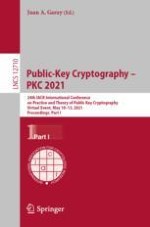
2021 | OriginalPaper | Buchkapitel
QCCA-Secure Generic Key Encapsulation Mechanism with Tighter Security in the Quantum Random Oracle Model
verfasst von : Xu Liu, Mingqiang Wang
Erschienen in: Public-Key Cryptography – PKC 2021
Aktivieren Sie unsere intelligente Suche, um passende Fachinhalte oder Patente zu finden.
Wählen Sie Textabschnitte aus um mit Künstlicher Intelligenz passenden Patente zu finden. powered by
Markieren Sie Textabschnitte, um KI-gestützt weitere passende Inhalte zu finden. powered by